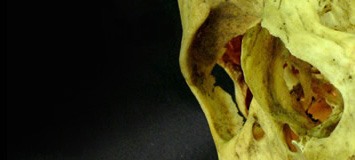Terms of Use
By using this website you unconditionally understand, accept, and agree to the following:
1. Access to and use of this website (including any of its information, data, code and/or files) is completely and strictly at your own risk. No guarantees or warranties, of any kind, are provided. You assume the entire risk of selection, download, installation and use of any files, links, and/or information contained on this website. There are no warranties or guarantees that any of the information, data, code and/or files on this website are error-free, or virus-free, or meet any performance criteria, quality, accuracy, purpose or need. CRANIOFACIALidentification.com and/or any of its contributors will not be held liable for any losses, injuries, or damages associated with the use of this website. This disclaimer is an essential and compulsory part of CRANIOFACIALidentification.com's Terms of Use.
2. Use of this website is not authorized without the unreserved and full acceptance of CRANIOFACIALidentification's Terms of Use.
3. This website, including its availability and the information it contains, is subject to change at any time and without notice.
4. Where any part of this website or its files/information/data are used by you to produce a subsequent piece of work, you will give written acknowledgments to CRANIOFACIALidentification.com in that work.
5. In addition to part 4, any subsequent piece of work that draws on the below stated features of this website will give references as follows:
| Website Feature | Requirements for Use in a Subsequent Piece of Work | |
|---|---|---|
C-Table |
a. In-text references to all relevant contributors to the C-Table in the form of their original manuscript publications (see C-Table contributor list); AND b. In-text references to |
|
T-Table |
a. In-text references to all papers used to generate the T-Table (see reference lists included with the T-Tables); AND b. In-text references to: |
|
BodyPlot |
In-text references to: a. Stephan CN, Preisler R, Bulut O, Bennett M. (2016) Turning the tables of sex distinction in craniofacial identification: Why females possess thicker facial soft tissues than males, not vice versa. American Journal of Physical Anthropology. 2016; 161: 283-295; AND b. Stephan CN, Meikle B, Bennett M. (2021) Body mass in human facial soft tissue thickness research: A lurking v ariable widely misinterpreted for other effects. Forensic Science International. In review. |
|
EasyECD |
In-text references to: a. Walsh S, Liu F, Ballantyne KN, van Oven M, Lao O, Kayser M. IrisPlex: A sensitive DNA tool for accurate prediction of blue and brown eye colour in the absence of ancestry information. Forensic Science International: Genetics 2011;5(3):170-80; AND b. Rollo RF, Ovenden JR, Dudgeon CL, Bennett MB, Tucker K, Stephan CN. (2018) The Utility of the IrisPlex System for Estimating Iris Colour of Australians from their DNA. Forensic Science International. Under Review. |
|
QuickCapture |
In-text references to: |
|
PerspectiveX |
In-text references to one of the following (depends on which one applies): |
|
SkullProfiler |
In-text references to the following four manuscripts: |
|
SkullXtremes |
In-text references to: |
|
Skull Averages |
In-text references to: |
|
TraumaVision |
In-text references to: Stephan CN, Caple J, Atkins J, Lynch J, Meikle B, Fisk W. Skeletal Evidence of Sharp–Force Disarticulation and Tissue Flensing in 54 Cases Exhibiting Approximately 4,200 Bone Strike Injuries. In Ross A & Cuhna E (Eds.) Dismemberment: Perspectives in Forensic Anthropology and Legal Medicine. Elsevier. 2018. In press . |
|
TDStats |
In-text references to: |
|
TDStats Output Zip Files from the latest C-Table |
In-text references to: b. In-text references to all relevant contributors to the C-Table in the form of their original manuscript publications (see C-Table contributor list); AND c. In-text references to: |
|
TDValidator |
In-text references to: |
